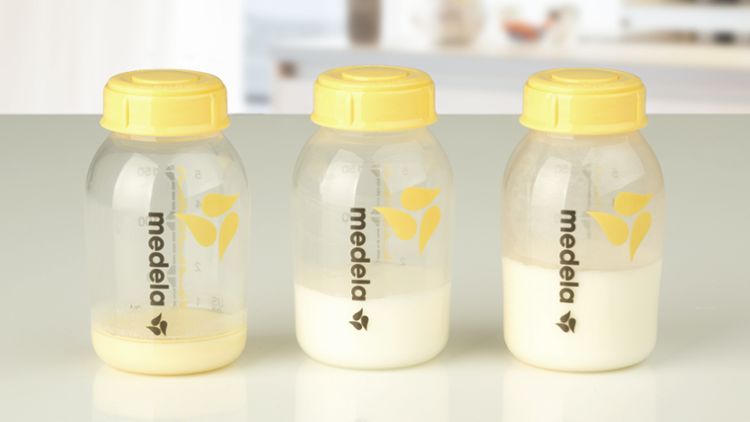As your baby’s first food, you might expect your breast milk ingredients to include basic essential nutrients, such as carbohydrates, proteins and fats, as well as water to keep her hydrated, which it does.1 But breast milk is no ordinary food – it has more value than nutrition alone.
What’s breast milk made of?
Here are some of the other constituents of human milk present at every feed, many of which can’t be replicated:
- Millions of live cells. These include immune-boosting white blood cells, as well as stem cells, which may help organs develop and heal.2
- More than 1,000 proteins3 that help your baby grow and develop, activate her immune system, and develop and protect neurons in her brain.
- All that breast milk protein is made up of amino acids. There are more than 20 of these compounds in your milk. Some of them, called nucleotides, increase at night and scientists think they may induce sleep.4,5
- Over 200complex sugars called oligosaccharides6 that act as prebiotics, feeding ‘good bacteria’ in your baby’s gut. They also prevent infections entering her bloodstream and lower her risk of brain inflammation.
- More than 40 enzymes.7 Enzymes are catalysts that speed up chemical reactions in the body. The ones in your milk have jobs such as aiding your baby’s digestion and immune system, as well as helping her absorb iron.
- Growth factors that support healthy development.1 These affect many parts of your baby’s body, including her intestines, blood vessels, nervous system, and her glands, which secrete hormones.
- On the subject of hormones, your breast milk contains lots of them!7 These clever chemicals send messages between tissues and organs to ensure they work properly.Some helpregulate your baby’s appetite and sleep patterns, and even aid the bond between you.
- Vitamins and minerals –nutrientsthat support healthy growth and organ function, as well as help build your baby’s teeth and bones.1
- Antibodies, also known as immunoglobulins. There are five basic forms of antibodies and all of them can be found in your milk.8 They protect your baby against illnesses and infections by neutralising bacteria and viruses.
- You may have heard of long-chain fatty acids because they play a pivotal partin building your baby’s nervous system, as well as aid healthy brain and eye development.9 And, you’ve guessed it, there are several of these in your milk too!
- 1,400 microRNAs, which are thought to regulate gene expression, as well as help prevent or halt disease development, support your baby’s immune system, and play a role in remodelling the breast.10
While this is a long list, it’s only some of the ingredients in your breast milk – and scientists are still discovering more. Remarkably, the levels of these ingredients can fluctuate over time, depending on your baby’s age and needs.
Let’s start at the beginning…
The first few days: Colostrum
The early milk your breasts produce after your baby’s birth is called colostrum. This thick, sticky breast milk is often called ‘liquid gold’, not just because of its yellow or orangey colour, but because it’s so important for nourishing and protecting your vulnerable newborn.
At first you’ll produce very small amounts – just 40 to 50 ml (1.4 to 1.8 fl oz) over 24 hours11 – but as your baby’s stomach is only the size of a marble, that’s all she needs. Colostrum is also very easy to digest. And what it lacks in quantity it makes up for in quality.
The composition of colostrum
Colostrum has the same ingredients that your later milk will have – it’s just that the amounts of these ingredients are different, as it’s tailored to your newborn’s needs.
For example, colostrum is sometimes referred to as a natural vaccination because its levels of antibodies and white blood cells are so high. Your first milk needs to contain these so it can protect your baby from infections and diseases after she leaves the safety of your womb.
Colostrum’s protective qualities are also important for your baby’s digestive system. Babies are born with a permeable gut lining, which colostrum coats and seals.12,13 This is particularly important if your baby is premature, as she’ll be more at risk from the dangerous gut condition necrotising enterocolitis (NEC).13
It’s also rich in minerals and vitamins, with higher concentrations of vitamins A, E and K than mature breast milk. The percentage of protein in colostrum is higher too.1 Colostrum also acts like a laxative that helps your baby pass her first poo, meconium.14
The next couple of weeks: Transitional milk
During the first week of your baby’s life, around two to four days after delivery, your breast milk changes in quantity. You may feel your breasts become fuller and firmer – a change known as your milk ‘coming in’. On the third day, your baby will consume 300 to 400 ml (10.5 to 14 fl oz) of breast milk per 24 hours, and by the fifth day this increases to 500 to 800 ml (18 to 28 fl oz), so it’s not surprising your breasts may feel bigger!11
From day five to 14, your milk is called transitional milk.15 As the name suggests, it’s changing from colostrum to mature milk. It becomes creamier in colour and texture, and also higher in fat, calories and lactose (a natural sugar), making it the ideal food for your rapidly growing newborn.
But rest assured it’s still full of protective antibodies, live cells, ‘good’ bacteria and other bioactive ingredients to help keep her healthy.15
Four weeks onwards: Mature milk
By the time your baby is four weeks old, your breast milk will be fully mature. It’s rich in protein, sugar, vitamins and minerals, plus numerous bioactive components – such as hormones, growth factors, enzymes and live cells – to support your baby’s healthy growth and development.7
From four weeks, the nutritional content and levels of ingredients in mature milk generally remain fairly consistent. But the composition of your breast milk can still change from day to day and feed to feed.
For example, if you or your baby are ill, your body will make antibodies to fight that particular illness, which become part of your milk. And, remarkably, as your baby begins exploring the world and putting toys in her mouth, the level of protective bacteria-fighting enzymes in your milk rises.16 This variation in breast milk composition shows how it adapts to your baby’s changing needs.
What are foremilk and hindmilk?
You may notice your milk seems thicker and creamier towards the end of a feed. This is because, as the feed progresses, the fat composition gradually increases due to the mechanics of milk moving through the breast. It’s often referred to as hindmilk, while the first more ‘watery’ milk is known as foremilk. These two names might lead you to think there’s a switch where foremilk becomes hindmilk, but there isn’t. The change is a gradual process.15 Both are essential parts of a completed feed, and rich in vitamins, minerals, protein and sugars.
Your milk’s fat content relates to how drained your breast is. Your breasts will be fuller at the start of some feeds (milk lower in fat) and more drained at the start of other feeds (milk higher in fat). So don’t worry too much about foremilk and hindmilk – over 24 hours your baby will end up consuming a similar amount of fat in total each day.17
Breast milk composition after six months
You may be wondering what happens to your milk if you continue breastfeeding long-term. Can your body really keep producing such high-quality mature milk for months and months, or even years? The answer is, don’t underestimate your breasts!
While it’s true you’ll need to start introducing solids at six months to bolster your baby’s stores of certain nutrients, such as iron,18 your milk will still make up a large part of her diet.
For example, when your baby is seven months old she will still be getting 93% of her calories from breast milk. Even between 11 and 16 months, around half of her daily calorie intake will be from milk.19
So relax in the knowledge that you can both continue to enjoy the benefits of breastfeeding for many months to come.






















